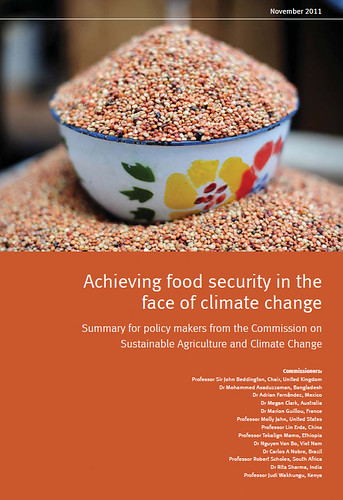The Commission on Sustainable Agriculture and Climate Change, an initiative of the CGIAR Research Program on Climate Change, Agriculture and Food Security (CCAFS), is identifying policy changes and actions needed to help the world achieve food security in the face of climate change; the Commission launched this summary for policymakers on 16 Nov 2011 (photo on cover by Neil Palmer/CIAT).
The current issue of New Scientist publishes an article describing a recently released study, ‘Achieving Food Security in the Face of Climate Change’, which was commissioned by the CGIAR Research Program on Climate Change, Agriculture and Food Security (Consultative Group on International Agricultural Research). For more on that study, see the CCAFS news release of 16 November 2011: ‘Global Commission Charts Pathway for Achieving Food Security in Face of Climate Change‘.
Sujata Gupta’s New Scientist article on meat consumption, ‘Just how much meat can eco-citizens eat?’ (online publication date: 16 November 2011; print issue date: 19 November 2011; print issue number: 2839), contains what we believe is a factual error. Gupta quotes a 2007 article in the Lancet (‘Food, livestock production, energy, climate change, and health’, doi:10.1016/S0140-6736(07)61256-2) that 80% of agricultural greenhouse gas emissions come from meat production.
More credible figures, compiled from international global assessments by agricultural systems analyst Mario Herrero and his colleagues at the International Livestock Research Institute, are the following.
The total agricultural sector emits around 25–32% of global anthropogenic greenhouse gas emissions. Crops emit 14% (EPA 2006) and all livestock emit 11–18%, depending on how emissions are attributed (FAO 2006, EPA 2006, PBL 2010). The emissions from livestock can be divided roughly as 30% methane from enteric fermentation, 30% nitrous oxide from manure management and 40% from carbon dioxide from land-use changes for grazing and feed production (FAO 2006). Figures for the emissions from land-use changes carry a lot of uncertainty. Emissions can also be divided by species and product. For example, the dairy sector is responsible for roughly 27% of greenhouse gas emissions from livestock (FAO 2010) while monogastric production (pigs/poultry) is responsible for 10–20% of the livestock emissions. Hence, it is not possible that beef production can account for 80% of all agricultural emissions. Even if beef cattle represent 50–60% of livestock emissions, this translates roughly into a figure close to 30–35% of all agricultural emissions—certainly not 80%. What is true is that of all livestock products, beef is the most inefficient in terms of greenhouse gas emissions produced per unit of product, especially compared to dairy and monogastrics (De Vries and de Boer 2010).
Herrero and his colleagues at ILRI, CCAFS and elsewhere are publishing updates on topics concerning livestock production and climate and other kinds of global change. Look out, for example, for the following book chapter, due next month, which we will report on in this blog: M Herrero, PK Thornton, P Havlík, and M Rufino, Livestock and greenhouse gas emissions: Mitigation options and trade-offs. In: E Wollenberg, A Nihart, ML Tapio-Bistrom and C Seeberg-Elverfeldt (eds), Climate Change Mitigation and Agriculture, Earthscan, London, UK (in press).
See an earlier report on a similar topic in this ILRI News Blog: Livestock and climate change: Towards credible figures, 27 Jun 2011.

